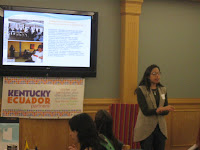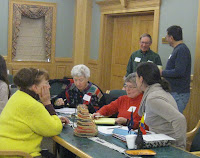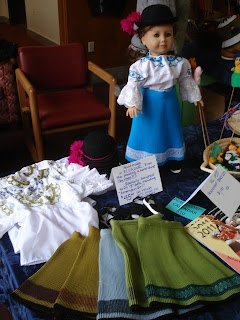The following is a series of posts from Ecuador by Jazmine Shoup, the recipient of Partners 2012 Ecuadorian Education Abroad Scholarship. Jazzy is traveling with the UK Honors Program lead by Kentucky Ecuador Partners Education chair, Dr. Larry Grabau.
A few days away!
May, 12, 2012
Week one!!
May, 19, 2012
These last two days have also been filled with incredible experiences! We were able to travel to the equator and learn about it! Very interesting! Then we went shopping to Otovalo and were able to buy so many cool textiles! Purses, bags, scarves, cups, paintings, sweaters, jewelry! You name it, they had it. And it was all hand crafted and beautiful! After Otovalo we had our one night home stay with a local family! We stayed with a family that had a mom and two daughters, all of whom were so kind and generous! The home stay was so much fun! We were able to help with preparing the tratiditional meal, and chat with the family in Spanish! Then we played UNO and just had a great time laughing and being with one another! Today was also a great day! We went for a morning hike in the Andes mountains! It was too beautiful for words! A picture couldn’t even do it justice! It’s something I would recommend everyone doing!! After that we went to Otovalo and visited with a man who hand crafted wool and wool textiles, and then to a house where they made hand crafted Ecuadorean instruments! I wish I could write more, but internet time is limited, so I will keep writing with updates as soon as I can!!
So many more adventures to have!!!!!!
Only in Ecuador!
May, 25, 2012
So now I am on to another day! And boy oh boy was this day exciting! We played with monkeys, hiked through the Amazon jungle, experimented with Amazonial medicinal treatments, swam in an incredible waterfall in the jungle, and visitd with a local village where we were able to have traditional markings of their people painted on our faces! So to say the least, the day was some what surreal and incredibly amazing! I have simply fallen in love with the culture, people, and beauty of Ecuador! Until another day!



 Skinner’s volunteer work with Partners of the Americas is acually a family affair that involves his wife, Ruthi; their son and daughter-in-law, Ian and Jill; their daughter and son-in-law, Erin and David Smith; and Rankin’s brother and sister-in-law, Donnie and Roberta. The family was honored as the FamilyAward Winners for 2009 by United Way of the
Skinner’s volunteer work with Partners of the Americas is acually a family affair that involves his wife, Ruthi; their son and daughter-in-law, Ian and Jill; their daughter and son-in-law, Erin and David Smith; and Rankin’s brother and sister-in-law, Donnie and Roberta. The family was honored as the FamilyAward Winners for 2009 by United Way of the










